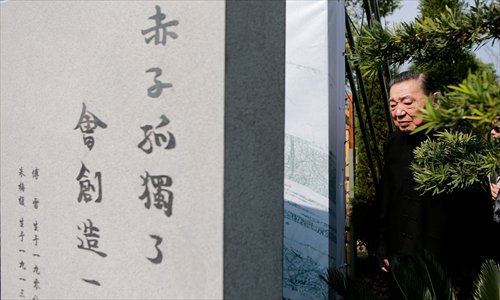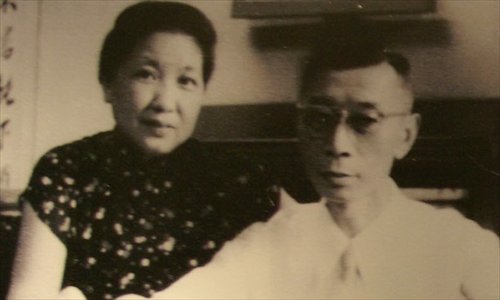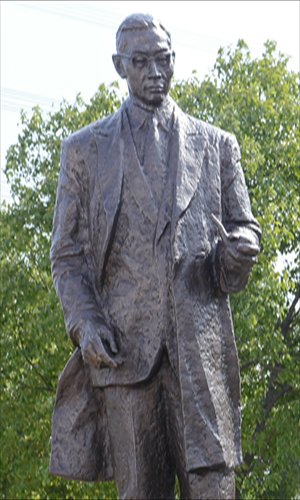Tragedy and triumph of a Chinese intellectual
A thunderous name to generations of readers, Fu Lei - remembered as the great translator of novels by Balzac and Romain Rolland and revered as a paragon of intellectualism who never compromised his integrity - may finally rest in peace now that his ashes have been returned to his hometown in Nanhui, Pudong New Area, and buried alongside his wife, Zhu Meifu, in a solemn ceremony attended by their two sons on Sunday, 47 years after the couple committed suicide on the same night.

Fu Cong, the elder son of Fu Lei, standing behind the memorial stone, mourning his parents after their ashes were buried in Nanhui on October 27. Photo: CFP
"The loneliness of an innocent heart leads to the creation of a new world," a line picked from Fu's famous family letters by his younger son, Fu Min, was inscribed as the epigraph on the 1.8-meter memorial. "The original design comprised two books, one in the traditional Chinese style and the other in the French fashion, but we decided it's better to keep it simple and modest, the way Fu Lei himself was," Wang Shuhua, the director of Fu Lei Culture Center, said.
Wang spent three years trying to persuade Fu's two sons to move Fu's ashes from a cemetery of revolutionary martyrs in Xuhui district to his hometown in Pudong. "How cruel that his wife had to be buried separately since she did not qualify as a 'martyr.' But more importantly, it was not just about Fu himself, because he also meant so much to the public," Wang said.
Born on April 7, 1908 and expelled from Xuhui College for his radical critique of religion at the age of 16, Fu went to France to study art theory and criticism at the University of Paris in 1928. Before he was hired as a professor to teach French and art at Shanghai Fine Arts College in 1931, he had already completed several translations of French fiction by Daudet and Mérimée, as well as an essay on Paul Cézanne.

Fu Lei (right) and his wife Zhu Meifu Photo: IC
The Chinese version of Rolland's Jean-Christophe, published in 1937, a novel deemed a must-read for every Chinese intellectual at the time, was enough to mark Fu's name forever in many hearts.
To some extent it was not even the book itself but Fu's "notes from the translator" on the first page that was unforgettable: "It's not a lack of darkness that makes the day bright and it's not a lack of fear that makes one a hero. A hero fights with fear all the time… When you know that other people are suffering too, you will feel less pain and your faith will be reborn from desperation."
By the year of 1964, Fu's translations had amounted to a startling 5 million words, including all three of Rolland's biographies of cultural giants, Beethoven, Michelangelo and Tolstoy, as well as 15 novels from Balzac's La Comédie humaine. It was widely acknowledged that without Fu there would be no Balzac in China.
It is debatable whether Fu's outstanding translations can ever be surpassed but Fu's charisma as a cultural hero is beyond dispute. He is respected, from generation to generation, not only because he was well learned in both Chinese and European culture and gifted in more than one realm of art. More significantly, he is a tangible role model who demonstrated that it is possible not to give in to the forces and temptations outside one's study and who kept working assiduously all his life, in short, a sort of Chinese counterpart of Beethoven, Michelangelo and Tolstoy.
From 1954 to 1966, Fu's letters to his two sons, the now world-renowned pianist Fu Cong (Fou Ts'ong) and Fu Min, a high school English teacher, were collected and published as a book in 1981, 15 years after Fu Lei and his wife ended their brutal persecution and humiliation during the Cultural Revolution (1966-76) by taking their lives. The letters were serious and sincere, epigram-riddled and down-to-earth. They were no less widely read than Fu's translations of novels through the years.

A new statue of Fu Lei stands outside the Zhoupu Art Museum. Photo: Courtesy of Wang Yafang
All the original manuscripts of Fu's family letters are currently on display at Zhoupu Art Museum, at the front gate of which stands a new statue of Fu Lei. The exhibition and the statue are also part of a series of events in celebration of the 105th anniversary of Fu's birth. "An exhibition on such a big scale has never been held before," Wang Shuhua told the Global Times.
The exhibition is divided into seven parts, tracing Fu's family tree back to 1,000 years before Confucius and presenting Fu's whole life with never-before-seen photos, as well as objects like the pipe depicted being held in the statue outside and a piano playlist he designed for Fu Cong.
"But Fu never had a photo of the whole family. The closest thing he had was four single portraits arranged together," Wang said. "The Fu family were really perfectionists. Every family letter was required to be copied. So here we have two types of letters, the ones written beautifully in Chinese brush by Fu Lei and the ones copied in pen by his wife," Wang Yafang, an employee at the museum, added.
After the exhibition at Zhoupu Art Museum ends on November 20, Wang Shuhua is planning to tour the exhibition around the country. "I think the noble qualities of Fu are especially valuable in this not-so-noble time," he said.